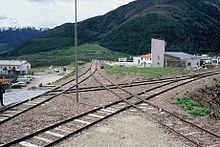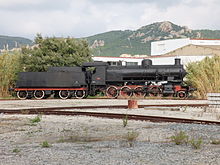Track pentagon

A Gleisfünfeck or turning star is a winding track figure in the form of a pentagram that for turning rail vehicles , especially steam locomotives with a Tender serves. It was used particularly in Italy in places where turntable maintenance was seen as problematic.
construction
The turning star consists of five points (two of them for entry and exit), three crossings and three star-shaped butt tracks .
Compared to a track triangle , as it is known in particular from American railways for turning, the track pentagon is more complex in terms of construction by two additional points and three crossings , but takes up significantly less floor space for a given minimum radius of the track curves.
The locomotive turns by pushing forwards and backwards several times, so-called sawing runs , whereby it first drives into an outer, then the inner and finally the other outer dead end, before turning and leaving the star to the other side. The multiple, time-consuming reversals for steam locomotives must be seen as an operational obstacle (in order to return to the starting track in a reversed direction, four changes of direction are necessary - six with coupling to return), but at least no switches have to be set within the star, as fallback switches were used .
Occurrence

Track pentagons are occupied from Northern Italy and Sardinia , specifically in South Tyrol at the train stations Mals , Brenner and Innichen as well as in Predazzo and Verona Porta Nuova . The system in Mals in particular is still completely preserved and has been available for museum trips since the Vinschgau Railway was reactivated in 2005 . The location of the dismantled turning star in Innichen can still be seen clearly in the structure of the terrain.
- Turning star Mals: 46 ° 41 ′ 0.4 ″ N , 10 ° 32 ′ 50.3 ″ E
- Innichen train station (dismantled): 46 ° 43 ′ 50.9 ″ N , 12 ° 16 ′ 14.4 ″ E
In Sardinia a turning star (Italian: stella di inversione ) has been preserved:
- Carbonia Train Station : 39 ° 10 ′ 2.6 ″ N , 8 ° 30 ′ 41 ″ E
- Oristano train station (dismantled): 39 ° 54 ′ 8.2 ″ N , 8 ° 36 ′ 21.9 ″ E
history
About the reason for this complicated and strange-looking figure is track in railway magazines been speculated repeated.

The thesis that has been expressed several times that the track pentagons were straightening systems for railway guns from the First World War has proven untenable : all track pentagons evidently emerged only later, in the interwar period, in the case of Mals as part of the expansion of the station in 1930. Also emerged in the three South Tyrolean train stations of Malles, Brenner and Innichen only became necessary after the First World War to turn tender locomotives: Brenner and Innichen were previously relatively insignificant transit stations and only became border train stations where locomotives turned after the division of Tyrol as a result of the peace treaty of Saint-Germain . And in the case of Mals, after the border was drawn, it was foreseeable that the originally planned continuation of the Vinschgau Railway as the Reschenbahn over the Reschenpass to Landeck would no longer be realized.
The city of Carbonia in Sardinia was only founded in 1937, the railway line was opened in 1956. The station in Oristano has existed since 1872, the Cagliari – Golfo Aranci Marittima line was taken over in 1920 by the Ferrovie dello Stato . When and why the track pentagon was built in the station is not known.
There is no doubt that the smaller space requirement compared to a track triangle (or even a turning loop ) was particularly advantageous in the mountains. A turntable that is widely used would have been even more space-saving , but its winter-proof operation with a lot of snow and ice could hardly have been guaranteed.
Model railway
Even on model railway layouts , track pentagons are very rare, despite the fact that the model is fascinating, not only because of the limited choice of specific models: at least for the three crossings in the track curve, no industrially manufactured track material is available. In addition, in the case of the two-wire system , the circuitry effort already required for reversing loops and track triangles is significantly increased by the three crossings: During the reversing process, the polarity of both rails must be swapped somewhere , without short-circuits occurring either before or after . Nevertheless, they have already been implemented successfully and reliably in the model.
Individual evidence
- ^ Helmut Petrovitsch: Wendesterne , in: Eisenbahn magazin 2/94, p. 25, Alba Verlag, Düsseldorf
- ↑ In the program "Eisenbahnromantik", episode 888: the Vinschgau Railway, the track pentagon in Malles is presented. SWR archive
- ^ Walter Canciani: La Ferrovia Ora-Predazzo , TrainZItalia Photo 2006
- ↑ Carmen Müller: Meran – Mals Vinschgau. On the trail of a disused railway line , Vienna: Folio, 2001, 170 pages, ISBN 3-85256-192-2
- ↑ Historical track plan of the Innichen train station (Italian: San Candido )
- ↑ FW Hoepke and Günter Niethammer: The secret of the track pentagons - revealed? , in: MIBA 9/66, MIBA Verlag, Nuremberg
- ↑ a b Hans Rothärmel: The turning of mini-club Tender locomotives by Gleisdreieck or terminal loop and Horst Röchling (Photos): The Gleisfünfeck of Mals / South Tyrol , in: MIBA 2/83, pp 116-119, MIBA Verlag, Nuremberg
- ↑ Moving the future! The Vinschgerbahn Merano-Malles , special railway publication volume III, Innsbruck: Eisenbahnarchiv Tirol, 2005
- ^ Joachim Rothkegel: The Reschenscheideckbahn and its planned connection projects to the north and south , Augsburg: Rösler + Zimmer, 1976, 48 pages, ISBN 3-87987-143-4
- ^ Moritz Gretzschel: Südtiroler Sternfahrt , in: MIBA 7/04, MIBA Verlag, Nuremberg


